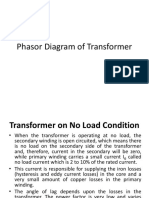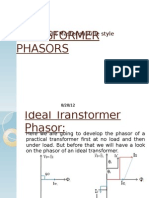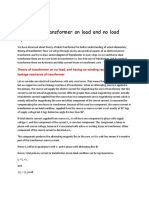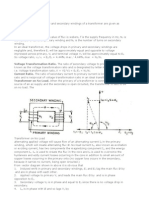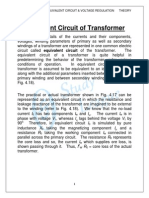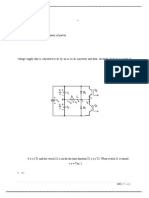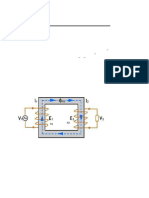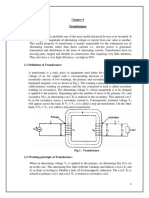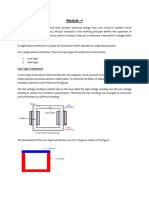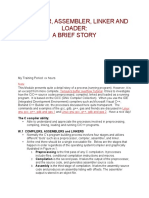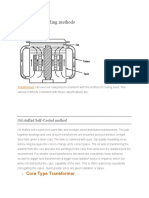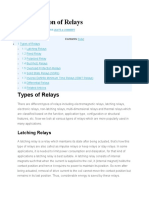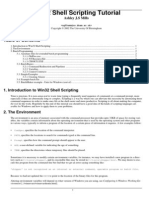Equivalent Circuit of Transformer Referred To Primary
Equivalent Circuit of Transformer Referred To Primary
Uploaded by
Gideon MoyoCopyright:
Available Formats
Equivalent Circuit of Transformer Referred To Primary
Equivalent Circuit of Transformer Referred To Primary
Uploaded by
Gideon MoyoOriginal Title
Copyright
Available Formats
Share this document
Did you find this document useful?
Is this content inappropriate?
Copyright:
Available Formats
Equivalent Circuit of Transformer Referred To Primary
Equivalent Circuit of Transformer Referred To Primary
Uploaded by
Gideon MoyoCopyright:
Available Formats
Equivalent Circuit of Transformer Referred to Primary
For drawing equivalent circuit of transformer referred to primary, first
we have to establish general equivalent circuit of transformer then, we
will modify it for referring from primary side. For doing this, first we need to
recall the complete vector diagram of a transformer which is shown in the
figure below.
consider the transformation ratio be,
Let us
In the figure above, the applied voltage to the primary is V1 and voltage
across the primary winding is E1. Total current supplied to primary is I1. So
the voltage V1 applied to the primary is partly dropped by I1Z1 or I1R1 +
j.I1X1 before it appears across primary winding. The voltage appeared across
winding is countered by primary induced emf E1. So voltage equation of this
portion of the transformer can be written as,
The equivalent circuit for that equation can be drawn as below,
From the vector diagram above,
it is found that the total primary current I1 has two components, one is no load component Io and the other is load component I2. As this primary
current has two components or branches, so there must be a parallel path
with primary winding of transformer. This parallel path of current is known
as excitation branch of equivalent circuit of transformer. The resistive and
reactive branches of the excitation circuit can be represented as
The load component
I2 flows through the primary winding of transformer and induced voltage
across the winding is E1 as shown in the figure right. This induced voltage E1
transforms to secondary and it is E2 and load component of primary current
I2 is transformed to secondary as secondary current I2. Current of
secondary is I2. So the voltage E2 across secondary winding is partly
dropped by I2Z2 or I2R2 + j.I2X2 before it appears across load. The load
voltage is V2. The complete equivalent circuit of transformer is shown below.
Now if we see the voltage drop in secondary from primary side, then it would
be K times greater and would be written as K.Z2.I2. Again I2.N1 = I2.N2
Therefore,
From above equation, secondary impedance of transformer referred to
primary is,
So, the complete equivalent circuit of transformer referred to primary is
shown in the figure below,
Approximate Equivalent Circuit of Transformer
Since Io is very small compared to I1, it is less than 5% of full load primary
current, Io changes the voltage drop insignificantly. Hence, it is good
approximation to ignore the excitation circuit in approximate equivalent
circuit of transformer. The winding resistance and reactance being in series
can now be combined into equivalent resistance and reactance of
transformer, referred to any particular side. In this case it is side 1 or
primary side.
Equivalent Circuit of Transformer Referred to Secondary
In similar way, approximate equivalent circuit of transformer referred to
secondary can be drawn.
Where equivalent impedance of transformer referred to secondary, can be
derived as
You might also like
- Verizon Internet Gateway Arc Xci55ax User GuideDocument167 pagesVerizon Internet Gateway Arc Xci55ax User GuideJordan OxleyNo ratings yet
- Equivalent Circuit of Transformer Referred To Primary and SecondaryDocument4 pagesEquivalent Circuit of Transformer Referred To Primary and SecondaryAbdullah Al Asik100% (2)
- Equivalent Circuit of Transformer Referred To Primary and SecondaryDocument6 pagesEquivalent Circuit of Transformer Referred To Primary and Secondarymiguelhernandez199No ratings yet
- PhasorDocument22 pagesPhasorAyyar KandasamyNo ratings yet
- 14 Transformer PhasorsDocument13 pages14 Transformer PhasorsShahnawaz AhmadNo ratings yet
- Equivalent Circuit Diagram of Single Phase TransformerDocument4 pagesEquivalent Circuit Diagram of Single Phase Transformerroniahmed119219No ratings yet
- PT2 (18 Pages)Document19 pagesPT2 (18 Pages)sampath kumarNo ratings yet
- Im 2Document36 pagesIm 2divya.babuNo ratings yet
- EMF EquationDocument2 pagesEMF EquationEddie CowanNo ratings yet
- Electrical Machines (K-18EL101) (Mid-Term Presentation)Document11 pagesElectrical Machines (K-18EL101) (Mid-Term Presentation)Noor Saba100% (1)
- 22EE303 Electrical Machines I Unit-IiDocument8 pages22EE303 Electrical Machines I Unit-IiNANDHAKUMAR ANo ratings yet
- TheoryDocument7 pagesTheoryJatin hemwaniNo ratings yet
- Transformer Phasor DiagramDocument21 pagesTransformer Phasor DiagramblbmalekNo ratings yet
- Electrical Machines (1phase T - F (31-141 Page)Document32 pagesElectrical Machines (1phase T - F (31-141 Page)Pratibha KumariNo ratings yet
- Unit 1 NotesDocument42 pagesUnit 1 Notesganesh ganeshNo ratings yet
- Machine (I)Document57 pagesMachine (I)sangamchaulagain1No ratings yet
- CP0981 01-Nov-2011 RM01Document83 pagesCP0981 01-Nov-2011 RM01Elangovan DevarajNo ratings yet
- BEE Unit-IIIDocument34 pagesBEE Unit-IIIharishcheeeNo ratings yet
- Unit - V InvertersDocument11 pagesUnit - V InvertersSukhpal SinghNo ratings yet
- Unit Iv InvertersDocument32 pagesUnit Iv Invertersswathi arshakotaNo ratings yet
- (Fig. 1.1) (Fig. 1.2) Built Around A Ring-Shaped Core (Fig. 1.3)Document7 pages(Fig. 1.1) (Fig. 1.2) Built Around A Ring-Shaped Core (Fig. 1.3)Калоян ТотевNo ratings yet
- Voltage Regulation of TransformerDocument6 pagesVoltage Regulation of TransformerMd Nahid HasanNo ratings yet
- Electrical Machines IDocument31 pagesElectrical Machines IThomas ConleyNo ratings yet
- 4,5. Transformers (1 Phase & 3 Phase)Document48 pages4,5. Transformers (1 Phase & 3 Phase)nakkasrinuNo ratings yet
- Transformer Loading - ElectronicsHubDocument15 pagesTransformer Loading - ElectronicsHubarjquwxpeNo ratings yet
- Unit 1 TransformersDocument39 pagesUnit 1 TransformersAyush Khandelwal100% (1)
- Irfan Munir: Name: Roll No: 15CE25 Lab Instructor's Signature:........... Date...................Document3 pagesIrfan Munir: Name: Roll No: 15CE25 Lab Instructor's Signature:........... Date...................Irfan MunirNo ratings yet
- Transformer Voltage RegulationDocument12 pagesTransformer Voltage RegulationAMARANATHAN UNo ratings yet
- Transformer 1Document25 pagesTransformer 1sadanandharijan144No ratings yet
- Soumi HazraDocument12 pagesSoumi Hazrasoumihazra30No ratings yet
- Auto TransformerDocument9 pagesAuto TransformershathaNo ratings yet
- Buck Boost ConverterDocument5 pagesBuck Boost ConverterG VigneshNo ratings yet
- RCC Institute of Information Technology Continuous Assessment - 1 (CA1) Academic Session: 2023-24 (Odd Sem)Document8 pagesRCC Institute of Information Technology Continuous Assessment - 1 (CA1) Academic Session: 2023-24 (Odd Sem)sreejitmondal1No ratings yet
- Transformers NotesDocument5 pagesTransformers NotessauravNo ratings yet
- TransfrormerDocument91 pagesTransfrormerArial96No ratings yet
- Chapter - 2 Transformers: 2.1 What Is A Transformer?Document23 pagesChapter - 2 Transformers: 2.1 What Is A Transformer?muralibeee2874No ratings yet
- Buck ConverterDocument31 pagesBuck Converterbalak144No ratings yet
- Transformer: Mahindra École Centrale EE101: Basic Electrical Engineering (Fall 2015) Experiment 10Document6 pagesTransformer: Mahindra École Centrale EE101: Basic Electrical Engineering (Fall 2015) Experiment 10nirmalaNo ratings yet
- Unit 2Document14 pagesUnit 2hariNo ratings yet
- OriginalDocument13 pagesOriginalSonic Hedgehog100% (1)
- DC To DC BoosterDocument4 pagesDC To DC BoosterIdrissa Nikiema100% (1)
- Transformers Lecture 2Document10 pagesTransformers Lecture 2Ritesh JindalNo ratings yet
- E1.08 (2016) Single Phase TransformerDocument5 pagesE1.08 (2016) Single Phase TransformerDalilahNo ratings yet
- Buck Boost ChopperDocument10 pagesBuck Boost ChopperBeast WarlordNo ratings yet
- Single Phase TransformerDocument8 pagesSingle Phase TransformerKrishna KorankarNo ratings yet
- Woldia University: A Non Ideal TransformerDocument24 pagesWoldia University: A Non Ideal TransformerKANDEGAMA H.R. (BET18077)No ratings yet
- Buck Converter Step-Down Converter: X in XDocument12 pagesBuck Converter Step-Down Converter: X in Xkashiub100% (1)
- Electrical Machines IIDocument49 pagesElectrical Machines IISuram Dileep ReddyNo ratings yet
- 7358 التقرير النهائي للتدريب الهندسي PDFDocument3 pages7358 التقرير النهائي للتدريب الهندسي PDFمنتظر احمد حبيترNo ratings yet
- Transformer: Principle of WorkingDocument13 pagesTransformer: Principle of WorkingM7MD ACADEMIANo ratings yet
- EE Operational LevelDocument5 pagesEE Operational LevelShaik KamaluddinNo ratings yet
- 3phase To 2phase Conversion in TransformersDocument4 pages3phase To 2phase Conversion in Transformersabcd sripathiNo ratings yet
- PSS Lab Manual PDFDocument109 pagesPSS Lab Manual PDFNmg KumarNo ratings yet
- 2-2 R18 - Electrical Machines - IIDocument50 pages2-2 R18 - Electrical Machines - IIeesaikumar039No ratings yet
- TRANSFORMERSDocument14 pagesTRANSFORMERSlukerichman29No ratings yet
- Chapter 1Document14 pagesChapter 1Dawit LijalemNo ratings yet
- Notes_PE_Unit 05Document28 pagesNotes_PE_Unit 05Tejas ShindeNo ratings yet
- Module 1Document14 pagesModule 1vishnukrvishnu636No ratings yet
- Clase Calculo Corr. Primaria.Document22 pagesClase Calculo Corr. Primaria.juanchopi783No ratings yet
- Porter Value Chain AiDocument1 pagePorter Value Chain AiGideon MoyoNo ratings yet
- Compiler and AssemblerDocument21 pagesCompiler and AssemblerGideon MoyoNo ratings yet
- Operating Characteristics of Synchronous MachineDocument8 pagesOperating Characteristics of Synchronous MachineGideon MoyoNo ratings yet
- Compiler and AssemblerDocument21 pagesCompiler and AssemblerGideon MoyoNo ratings yet
- Expectancy Theory Vroom HR MotivationDocument2 pagesExpectancy Theory Vroom HR MotivationGideon MoyoNo ratings yet
- Transformer Cooling Method1Document12 pagesTransformer Cooling Method1Gideon MoyoNo ratings yet
- Construction of Circle DiagramDocument18 pagesConstruction of Circle DiagramGideon Moyo100% (1)
- Transfer Functions Examples Part 1Document21 pagesTransfer Functions Examples Part 1Gideon Moyo0% (1)
- Characteristic of Shunt Wound DC GeneratorDocument10 pagesCharacteristic of Shunt Wound DC GeneratorGideon MoyoNo ratings yet
- Classification of RelaysDocument13 pagesClassification of RelaysGideon MoyoNo ratings yet
- Harare Power StationDocument4 pagesHarare Power StationGideon MoyoNo ratings yet
- Two Port ParametersDocument2 pagesTwo Port ParametersGideon Moyo100% (1)
- Principle Operation of Synchronous MotorDocument9 pagesPrinciple Operation of Synchronous MotorGideon MoyoNo ratings yet
- Models of Two-Port Networks Z, Y, H, ParametersDocument17 pagesModels of Two-Port Networks Z, Y, H, ParametersGideon MoyoNo ratings yet
- Medium Voltage SwitchgearDocument5 pagesMedium Voltage SwitchgearGideon MoyoNo ratings yet
- Parallel Operation of Transformers IIIDocument3 pagesParallel Operation of Transformers IIIGideon MoyoNo ratings yet
- A Critical Review of Epistemological and Methodological Issues in CrossDocument11 pagesA Critical Review of Epistemological and Methodological Issues in CrossGideon MoyoNo ratings yet
- Use of Measuring InstrumentsDocument47 pagesUse of Measuring InstrumentsGideon MoyoNo ratings yet
- Milton Friedman Was Wrong About Corporate Social ResponsibilityDocument7 pagesMilton Friedman Was Wrong About Corporate Social ResponsibilityGideon MoyoNo ratings yet
- Research Article Plasmodium FalciparumDocument5 pagesResearch Article Plasmodium FalciparumIsmail IkhsanNo ratings yet
- Introduction To NeurotransmittersDocument27 pagesIntroduction To NeurotransmittersSuri khairatiNo ratings yet
- Lean KaizenDocument23 pagesLean KaizenMasha_Davidoff09No ratings yet
- Virtue Field Support BuildingDocument1 pageVirtue Field Support BuildingAlex AbramiNo ratings yet
- Name: Christine Ndanu ADMISSION NO: BBM/2041 /18 Unit: Total Quality in Supply Chain Management Unit Code: BBM 445 Assignment: CatDocument4 pagesName: Christine Ndanu ADMISSION NO: BBM/2041 /18 Unit: Total Quality in Supply Chain Management Unit Code: BBM 445 Assignment: CatHashi MohamedNo ratings yet
- QGS 75-100 Parts Manual - July 24 2020Document202 pagesQGS 75-100 Parts Manual - July 24 2020Сергей Колесников100% (1)
- Grammar Test Sem 1 2021-2022Document15 pagesGrammar Test Sem 1 2021-2022NavenashaNo ratings yet
- Numbers. Divisibility Tests, HCF and LCMDocument74 pagesNumbers. Divisibility Tests, HCF and LCMvishaljalanNo ratings yet
- Artistic Skills and TechniquesDocument66 pagesArtistic Skills and TechniquesAnnabelle ApostolNo ratings yet
- Edited Nick Resume 2Document1 pageEdited Nick Resume 2api-271174441No ratings yet
- Computer GenerationsDocument13 pagesComputer GenerationsMuhammad BILALNo ratings yet
- Geotechnical Engineering - University of AucklandDocument5 pagesGeotechnical Engineering - University of AucklandMuhammad Akbar WalennaNo ratings yet
- Penny: Pull-AlongDocument17 pagesPenny: Pull-AlongMauro RegisNo ratings yet
- Mix Design of Bituminous Concrete by Bailey MethodDocument6 pagesMix Design of Bituminous Concrete by Bailey Methodanon_370570207No ratings yet
- Introduction To Win32 Shell ScriptingDocument9 pagesIntroduction To Win32 Shell ScriptingKishore BramhamdamNo ratings yet
- A Detailed Lesson Plan in TTLDocument4 pagesA Detailed Lesson Plan in TTL안아ANANo ratings yet
- NFSWDocument3 pagesNFSWLucian MiricaNo ratings yet
- B37690A OM Easygen-1800 DDocument36 pagesB37690A OM Easygen-1800 DDieinathon BentoNo ratings yet
- The New Media Invasion: Digital Technologies and The World They UnmakeDocument229 pagesThe New Media Invasion: Digital Technologies and The World They Unmakeeverpresent5100% (2)
- Dasypus Novemcinctus,: Assessment By: Loughry, J., Mcdonough, C. & Abba, A.MDocument11 pagesDasypus Novemcinctus,: Assessment By: Loughry, J., Mcdonough, C. & Abba, A.Mnatalia chamorro solorzanoNo ratings yet
- Theories: Unit 13 TraditionalDocument10 pagesTheories: Unit 13 TraditionalVaishnav KumarNo ratings yet
- English Test Paper UTDocument5 pagesEnglish Test Paper UTkritikatusid17No ratings yet
- Marine Structures: Xiang Liu, Gang Li, Robert Oberlies, Qianjin YueDocument23 pagesMarine Structures: Xiang Liu, Gang Li, Robert Oberlies, Qianjin YueLiu XiangNo ratings yet
- Coding Decoding Quiz-IIIDocument6 pagesCoding Decoding Quiz-IIIHarsha HaridasNo ratings yet
- The Key To Classroom ManagementDocument12 pagesThe Key To Classroom Managementchris orlanNo ratings yet
- Cost Accounting 309Document19 pagesCost Accounting 309Vamba S. KamaraNo ratings yet
- Satip A 004 03Document3 pagesSatip A 004 03Anonymous 4e7GNjzGW100% (1)
- The Hollow of Three Hills by Nathaniel HawthorneDocument7 pagesThe Hollow of Three Hills by Nathaniel Hawthorneayeshabatool.saqiNo ratings yet
- Junaid Ahmad DarDocument12 pagesJunaid Ahmad Dar7ywtyc8rr7No ratings yet



